Table of contents
- Buying advice: Youngtimer motorcycles Buy motorcycle youngtimers up to 1000 euros properly
- Honda XBR 500 / S (1985 – 1990) new price 1990: 6650 marks
- Honda CX 500 (1977 – 1987) new price 1977: 5600 marks
- Honda CB 450 S (1986-1989) new price 1986: 5888 marks
- Moto Guzzi V 35 (1977-1979)
- MZ ETZ 150
- Suzuki DR 600 S, SN 41A (1984-1989) new price 1984: 6700 marks
- Suzuki GSX 750 E (1980 – 1983) new price 1981: 8211 marks
- Suzuki GT 125 (1974-1980) new price 1975: 2770 marks
- Yamaha XS 400, 2A2 (1978-1982) new price 1978: 4,300 marks
- Yamaha FJ 1200 (Type 1XJ: 1986 – 1987) New price 1986: 13,888 marks
- Yamaha XJ 750 Seca (1982 – 1984) original price 1982: 8715 marks
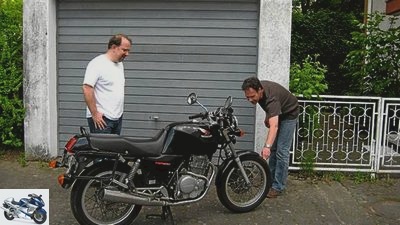
Holzwarth
counselor
Used purchase
Buying advice for youngtimers up to 1000 euros
Buying advice: Youngtimer motorcycles
Buy motorcycle youngtimers up to 1000 euros properly
Content of
Buy cheap and then repair expensive? Not a good tactic. With the right strategy and a little luck, on the other hand, you can find well-kept, everyday motorcycles that are suitable for everyday use, even for little money.
Uli Holzwarth
07/14/2011
Let’s not kid ourselves: The search for the pearls in the oil sump of the youngtimer market is more for the hard-core, who are not deterred by bankruptcies, bad luck and breakdowns.
Used warranties or dealer warranties? Doesn’t exist in the 1000 euro league. On the other hand, there is often no shortage of defects, both obvious and hidden. Experience shows that the seventh or eighth owner of a machine no longer has much to do with care and maintenance. Sometimes not with the truth either: Frustration and disappointment due to fancy advertisements are part of everyday life when looking for low-budget bikes.
Doesn’t that put you off? Great, then the search can begin. Because the chances of finding a well-preserved youngtimer in the huge range of the lowest price category are actually not that bad. Provided you follow a few rules, keep a cool head and act with common sense. But that takes time. And a lot of knowledge.
So first collect all the information you can get about the motorcycles in question. No matter whether at the dealer around the corner or in the relevant internet forums. Do not focus on a specific model or equipment, but also consider alternatives. Especially if a good overall condition and a traceable history speak for it. In addition, the self-imposed restriction to only one type of motorcycle sometimes lengthens the search considerably, and you put yourself under unnecessary pressure.
Isn’t it that far with the screwdriver talent? Then models that are known for their robust mechanics and reliability are preferred. Exotics, including those made in Japan, are only second choice in this price range, because spare or used parts are now (expensive) in short supply for bikes that were once in little demand.
Also be careful with throttled motorcycles, especially those with 27 hp. Many of these 80s models were stuffed with a high level of technical effort in order to be able to offer them in the entry-level class that was popular at the time. An effort that is taking its toll nowadays, because uncorking even with used parts is far beyond the economically justifiable framework. With a Honda VT 500 E, for example, different camshafts, manifolds and carburettors are required – each in a double pack, of course.
A voluntary self-restraint is recommended for the research. Experience has shown that a tour of the other end of the country does not make sense with 1000-euro motorcycles. Just burn a quarter of the planned purchase price for fuel? The risk of a nasty disappointment on site is simply too great for that. Even if the (not very informative) photos on the Internet promise something else.
In addition, it is important to sort out dubious offers when viewing the advertisements. Formulations like “TuV no problem” or “small quirk that can be easily fixed”, are always a reason for suspicion: If it were actually that easy, a reputable provider would have done it long ago. In addition: without a valid general inspection, re-registration or registration will fail.
The top priority during the on-site visit: four eyes see more than two. So never go to a viewing alone. And don’t let yourself be pressured (“More interested parties will come soon”). Instead, search meticulously for worn parts and telltale structural damage (rust in the tank, overaged tires, brittle rubbers). A sufficiently long test drive is of course mandatory, as is a written sales contract. When in doubt, the motto is: hands off, it is better to trust your gut feeling!
Then the search continues, the next opportunity is sure to come. Good for those who don’t get into a frenzy. After all, the low-budget segment is the territory of hunters and gatherers. We shouldn’t kid ourselves.
Honda XBR 500 / S (1985 – 1990) new price 1990: 6650 marks

Uli Holzwarth
Top: Neat first-hand XBR with 20,000 kilometers, bought for 1,000 euros.
The Honda XBR 500 is one of the very few character bikes that are available in usable condition for around 1000 euros. Just wonderful how the stew massages the eardrums with its dull bollern. The fact that it can do this reliably with regular maintenance (valve clearance, oil change!) Even at higher mileages makes the little Honda even more desirable to me.
In any case, the harmonic 500 shows a remarkable condition in single circles. Just as convincing are the manners of the supple single-cylinder: problem-free starting behavior, little vibration, and it pulls ahead even in the low rev range without hacking. The touring suitability is also great, thanks to the comfortable seating position, large tank and low fuel consumption. Okay, the turning behavior takes a bit of getting used to, but even beginners can get along with the Honda without any problems.
And old hands, the 44 hp are enough to draw an astonishingly brisk line on winding country roads. But that’s actually a minor matter. Because with the XBR, it is the sound that makes the music.
This often causes problems:
Worn struts
Loose spokes
Defects in the starter freewheel (with higher mileage)
Dethrottling to 44 HP for models up to 1987 expensive (including camshaft)
Drive:
Air-cooled single-cylinder four-stroke engine, displacement: 498 cm3; Output: 32 kW (44 PS) at 7000 rpm; (Variant: 20 kW (27 PS) at 6000 rpm); Five-speed gearbox; Chain drive
Landing gear:
Single tube frame with forked steel tube beams; Telescopic fork at the front, Ø 35 mm, two spring struts at the rear; Spring travel: 140/110 mm (f / h); Spoked wheels; Tires: 100/90 S 18, 110/90 S 18 (v / h); Brakes: front disc, rear drum
Dimensions:
Tank capacity: 20 liters; Weight: 182 kg
0-100 km / h:
6.8 s (27 hp: 8.3 s)
Top speed: 174 km / h (27 PS: 138 km / h)
Strengthen:
Very stable engine with regular maintenance
Good running culture
Enthusiastic sound
Great coverage
Weaknesses:
Turning behavior takes getting used to
Mileage at prices from 800 to 1000 euros: around 30,000 to 50,000 kilometers
Honda CX 500 (1977 – 1987) new price 1977: 5600 marks
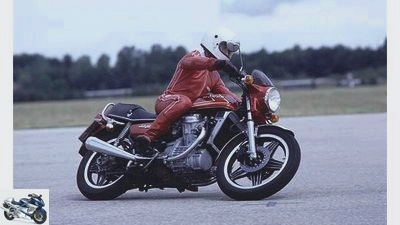
archive
Cult bike Honda CX 500.
The Honda CX 500 is recommended to leisurely touring riders. With cardan shafts, tubeless tires, water cooling, H4 lights and double discs at the front, the cult bike still offers carefree touring qualities today.
Your engine is considered to be extremely durable and frugal. Almost 22,000 copies of the original version offered from 1978 to 1982 cannot be wrong. In addition, there are another 15,000 of the soft chopper CX 500 C. Spare parts are rarely needed because the CX runs and runs and runs.
150,000 km and more are not uncommon. The only weak point: the timing chain tensioner. Later models had a reinforced one. If it rattles clearly: hands off! Because the engine has to be taken out to swap. The 50 hp version, however, should be. It’s a lot more fun than the 27 hp machine. The 37 kW carburettor and a milling cutter for the manifold reduction are required for dethrottling.
Information is available at www.guellepumpe.de and www.cx500-online.de.
This often causes problems:
Timing chain tensioners of the first models can break
Rear silencer relatively susceptible to rust
Starting difficulties after a long period of standstill
Drive:
Liquid-cooled two-cylinder V-four-stroke engine, displacement: 496 cm3; Output: 37 kW / 50 PS at 9000 rpm (variant: 20 kW / 27 PS at 6500 rpm); Five-speed gearbox; Cardan drive
Landing gear:
Monotube frame; Telescopic fork at the front, Ø 33 mm, two spring struts at the rear; Spring travel: 140/85 mm (f / h); ComStar wheels; Tires: 3.25 S-19, 3.75 S-18 (v / h); Brakes: double disc front, Ø 240 mm; Rear drum, Ø 160 mm
Dimensions:
Tank capacity: 17 liters; Weight: 221 kg (full tank)
0-100 km / h:
5.4 s (27 hp: 8.7 s)
Top speed:
183.7 km / h (27 PS: 146.4 km / h)
Strengthen:
Durable engine
Low maintenance cardan
Powerful engine
Good brakes
Weaknesses:
Complex throttling
Spongy landing gear
Gabel likes to punch through
Mileage at prices from 800 to 1000 euros: around 50,000 to over 100,000 kilometers
Honda CB 450 S (1986-1989) new price 1986: 5888 marks

archive
Middle class bike CB 450 S.
Tubular space frame? Two-cylinder? No, this is not about a Ducati, but about Honda’s beautiful mid-range CB 450 S. The centerpiece, the wonderfully robust sounding, 44 hp three-valve twin, delights with pleasantly even power delivery and low consumption.
The former also applies to the version with 27 HP, because the throttling offered by the factory (via camshaft, nozzle needles and smaller pinion) was very complex, but also quite expensive. The handy, well-made and durable Honda is still a feast for the eyes and ears for me today.
This often causes problems:
Bad starting behavior after a long period of standstill
Increasing engine vibrations indicate that the balance shaft chains need to be retightened
Drive:
Air-cooled in-line two-cylinder four-stroke engine, displacement: 447 cm³; Output: 32 kW (44 PS) at 9000 / min (variant: 20kW / 27 PS at 7000 / min); Six-speed gearbox, chain drive
Landing gear:
Tubular steel frame, telescopic fork at the front Ø 35 mm, two spring struts at the rear; Spring travel: 140/100 mm (f / h); Cast wheels; Tires: 100/90 S 18, 110/90 S 18 (v / h); Brakes: double disc in front, drum in rear
Dimensions:
Tank capacity: 18 liters; Weight: 141 kg;
0-100 km / h:
6.5 s (11.4 s)
Top speed:
175 km / h (27 PS: 141 km / h)
Strengthen:
Handy chassis
Long-lasting, economical engine
Effective brakes
Weaknesses:
Poor, too hard struts
Complex, expensive (de) throttling
Mileage at prices from 600 to 1000 euros: around 30,000 to 70,000 kilometers
Moto Guzzi V 35 (1977-1979)
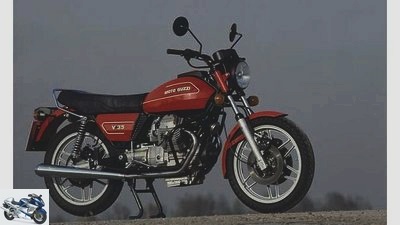
archive
a great touring motorcycle with a large tank and fantastic handling: Moto Guzzi V 35.
Moto Guzzi V 35. The smallest V2 Guzzi comes from the same era as the Suzuki, but comes from a different planet. Four-stroke V2, as in the large Guzzis, installed transversely, dry clutch, separate gearbox, cardan drive. A great little touring motorcycle with a sufficiently large tank and fantastic handling. In contrast to the more powerful V 50 and V 65 models, the small ones have a long drive train. The sometimes sloppy processing of the little Guzzis must be taken into account. There is also a lot of tinkered device on the market, make sure that it is in its original condition.
This often causes problems:
Toothing of the sliding pieces in the cardan drive
Universal joint
Sagging bench
Exhaust valves burned down
Rusted silencers
Drive:
Air-cooled V2 cylinder four-stroke engine, displacement: 346 cm3; Output: 20 kW (27 hp) at 7900 rpm, torque: 27 Nm at 6200 rpm; Five-speed gearbox; Cardan drive
Landing gear:
Double loop tubular steel frame; Engine bearing; Telescopic fork at the front, two struts at the rear; Spring travel: 130/80 mm (f / h); Cast wheels; Tires: 3.00 – 18, 3.25 – 18 (v / h); Brakes: double disc front, single disc rear, integral foot brake
Dimensions:
Tank capacity: 16.5 liters; Weight: 155 kg
0-100 km / h:
8.5 s
Top speed:
140 km / h
Strengthen:
Great handling
Integral brake
robust engine sound
Thrifty
weaknesses:
Paint quality
processing
Instruments
Mileage at prices from 800 to 1000 euros: around 50,000 to 70,000 kilometers
MZ ETZ 150
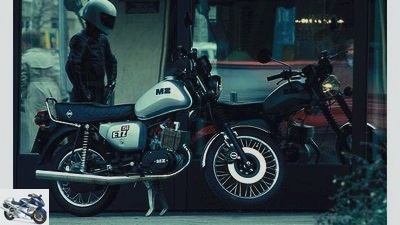
archive
As a second or seventh moped, the ultra-handy lightweight is still a lot of fun today.
Ease of maintenance and repair – always a very important purchase criterion. The one built in exactly 198016 copies MZ ETZ 150 was anything but exotic in the GDR, but in the West it never stood a chance against the not exactly inflationary TS and ETZ 250. Wrongly, because the 150 MZ is the much more modern motorcycle. As a second or seventh moped, the ultra-handy lightweight is still a lot of fun today and costs almost nothing to buy and maintain.
This often causes problems:
moisture-sensitive electrics
Oil leaks
Rear rubber hub dissolves
Vibration damage
Drive:
Air-cooled single-cylinder two-stroke engine, displacement: 143 cm3; Output: 10.5 kW (14.3 PS) at 6500 rpm (variant: 9 kW / 12.2 PS at 6000 rpm); Five-speed gearbox; Chain drive
Landing gear:
Rectangular profile frame made of sheet steel; Telescopic fork at the front, Ø 35 mm, two spring struts at the rear; Suspension travel: 185/105 mm (f / h); Wire spoke wheels; Tires: 2.75 R 18, 3.25 R 16 (v / h); Brakes: front disc, Ø 280 mm; Rear drum, Ø 150 mm
Dimensions:
Tank capacity: 13 liters; Weight: 118-122 kg
0-80 km / h:
11.0 s
Top speed:
110 km / h
Strengthen
Handy chassis
Comfortable suspension
High reliability
Very cheap upkeep
weaknesses
Moderate processing
Sensitive electrics
Mileage at prices from 500 to 800 euros: around 12,000 to 30,000 kilometers
Suzuki DR 600 S, SN 41A (1984-1989) new price 1984: 6700 marks
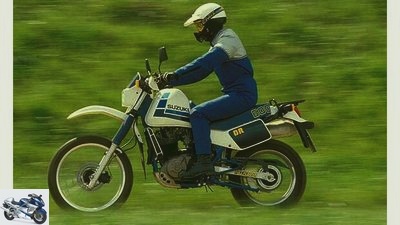
archive
Standard 20 liter tank and enormous seat height allow relaxed tours.
The qualities of the Dr 600 S are still fascinating today: The steam hammer offers double ignition and flat slide carburetors and impresses with its sophisticated and – thanks to two balance shafts – low-vibration engine. Its standard 20-liter tank and the enormous seat height allow relaxed tours far beyond the horizon, including off-road. Unfortunately, the build quality was lacking. The rust usually gnaws at the frame and exhaust. Many of the still approved specimens are therefore on the road with the robust-sounding Sebring pot.
In order to find a usable DR for 1000 euros, you should invest time in searching and viewing. Heavy rust, many previous owners and tough off-road use leave their marks. The condition of the wearing parts and bearings provides information about maintenance. If there is a loud rattle from the engine, the balance shaft chain may be over – better hands off. If you don’t like screwing, you should invest a few more bills in a better-maintained first or second hand model.
That often causes problems:
Problematic starting behavior in models up to 1986
Clutch wears out prematurely
Rust-prone frame and exhaust
Front brake tab
drive:
Air / oil-cooled single-cylinder four-stroke engine, displacement: 590 cm3; Output: 33 kW / 45 PS at 6800 rpm (variant: 20 kW / 27 PS at 3200 rpm); Five-speed gearbox; Chain drive
landing gear
Single loop frame; Front fork, Ø 39 mm; Full floater system at the rear; Suspension travel: 240/222 mm (f / h); Wire spoke wheels; Tires: 100 / 80-21, 130 / 80-18 (v / h); Brakes: front disc, Ø 240 mm; Rear drum;
Dimensions:
Tank capacity: 20 liters; Weight: 166 kg (full tank);
0-100 km / h:
6.4 s
Top speed:
150 km / h (27 PS: 131 km / h)
Strengthen:
Refined engine
Screwdriver-friendly
Good suitability for travel
Weaknesses:
Rust-prone exhaust
Gear ratio too long
Mileage at prices from 800 to 1200 euros: around 40,000 to 65,000 kilometers
Suzuki GSX 750 E (1980 – 1983) new price 1981: 8211 marks
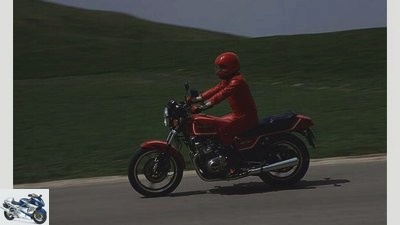
archive
Suzuki’s first in-line four-cylinder with a plain bearing crankshaft and four-valve cylinder head.
The workmanship of the GSX 750 E is of high quality. Suzuki’s first in-line four-cylinder with a plain bearing crankshaft and four-valve cylinder head. There are often very well-preserved specimens for little money that are a lot of fun with their 80 hp. It is nice that the 750er offers a very comfortable seating position and enough space for two people. Collectors pay attention to a well-preserved original exhaust system.
This often causes problems:
Rust-prone exhaust system
Steering head bearings
Worn struts
Carburetor system
Rust on weld seams
Drive:
Air-cooled inline four-cylinder four-stroke engine, displacement: 742 cm3; Output: 59 kW (80 PS) at 9200 rpm, torque: 63 Nm at 8400 rpm; Five-speed gearbox; Chain drive
Landing gear:
Double loop tubular steel frame; Telescopic fork at the front, Ø 35 mm, two spring struts at the rear; Suspension travel: 150/107 mm (f / h); Cast wheels; Tires: 3.25-19, 4.00-18 (v / h); Brakes: double disc in front, single disc in rear
Dimensions:
Tank capacity: 24 liters; Weight: 242 kg
0-100 km / h:
4.2 s
Top speed:
202 km / h
Strengthen:
Stable chassis
Robust engine
Comfortable sitting position
Big tank
Weaknesses:
Optics are not for everyone
Rust-prone exhaust system
often tinkered with
Mileage at prices from 800 to 1000 euros: around 50,000 to 70,000 kilometers
Suzuki GT 125 (1974-1980) new price 1975: 2770 marks
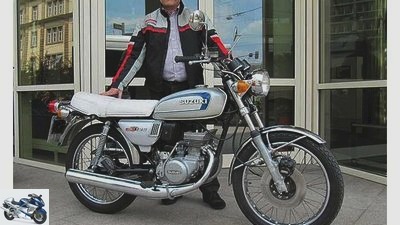
archive
Slim and logical line, lots of chrome and lots of aluminum: Suzuki GT 125.
The driving experience on a Suzuki GT 125 is incomparable. Almost nothing goes below 7000 / min, above that and between 8950 / min and 10200 / min the moped fires 14 hp into the world with a bombastic howl. Pure spectacle without making any relevant progress. At a good 120 km / h it is over, on the mountain you have to deliberately shift down. Driving is a job here.
The small two-stroke flirts with slim and logical lines, lots of chrome and lots of aluminum: polishing is fun. The lamp and turn signals are also nicely designed, showing great attention to detail. The engines are considered to be quite reliable. The weak alternators are known.
This often causes problems:
Clamping brake caliper
Poor alternator performance
Worn struts
Leaking air filter box
Steering head bearings
Swing arm bearing worn
Drive:
Air-cooled in-line two-cylinder two-stroke engine, displacement: 123 cm3; Output: 10.5 kW (14 hp) at 9500 rpm; Torque 12.7 Nm at 9000 rpm, wet clutch, five-speed gearbox; Roller chain
Landing gear:
Single-loop tubular steel frame; Telescopic fork at the front, Ø 32 mm, two spring struts at the rear; Spring travel: 120/100 mm (f / h); Wire spoke wheels with steel rims; Tires: 2.75-18, 3.00-18 (v / h); Brakes: single-disc floating caliper at the front, drum at the rear
Dimensions:
Tank capacity: 10.0 liters; Weight: 118 kg
0-100 km / h:
10.5 s
Top speed:
127 km / h
Strengthen:
Lively engine
Handy chassis
Great sound
Easy to screw
weaknesses:
High consumption
Sensitive electrics
Chrome parts expensive
Mileage at prices from 400 to 600 euros: around 25,000 to 35,000 kilometers
Yamaha XS 400, 2A2 (1978-1982) new price 1978: 4,300 marks
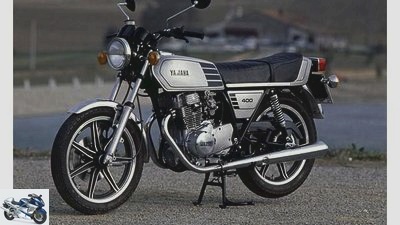
archive
Yamaha’s XS 400 is a solid and affordable classic that invites you to take turns with its lively OHC twin.
A classic: the Yamaha XS 400, although not suitable for off-road activities. But always handy, light and reliable to have a lot of fun with its 27 hp on narrow, winding roads. For a thousand there are well-hung copies of the model 2A2, which is equipped with round headlights and beautifully decorated with tank paint.
The first facelift came in 1979: In addition to the modified chassis geometry, there was a larger tank, a combined steering / ignition lock and a drum brake at the rear. Due to their widespread use, there are hardly any problems with spare parts. Only original exhausts and tanks in good condition are rare. The starter freewheel caused problems every now and then. Some then did without the push of a button and just kicked them. But that’s it with technical nastiness. A good 5300 of the twins are still on the road in Germany today. www.xs400.de and www.xs400.net take great care of maintaining them.
This often causes problems:
Swing arm bearings wear out quickly
Sensitive electric starter
The exhaust system and seat base plate tend to rust through
Ignition likes to pretend.
Drive:
Air-cooled two-cylinder four-stroke engine, displacement: 391 cm3; Output: 20 kW / 27 PS at 7000 rpm; two Mikuni constant pressure carburettors, Ø 34 mm; Six-speed gearbox; Chain drive
Landing gear:
Double tube frame; Telescopic fork at the front, Ø 33 mm, two spring struts at the rear; Spring travel: 140/80 mm (v / h); Cast wheels; Tires: 3.00 S-18, 3.50 S-18 (v / h); Brakes: front and rear discs, Ø 267 mm
Dimensions:
Tank capacity: 10.8 liters; Weight: 176 kg (full tank)
0-100 km / h:
8.0 s
Top speed:
145 km / h
Strengthen
Reliable engine
Handy chassis
Good touring suitability
Good spare parts situation
Weaknesses:
No H4 light
Small tank
Tends to commute
Mileage at prices from 800 to 1000 euros: around 20,000 to 45,000 kilometers
Yamaha FJ 1200 (Type 1XJ: 1986 – 1987) New price 1986: 13,888 marks
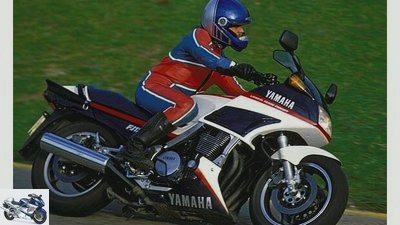
archive
The Yamaha FJ 1200 lures with seating comfort for driver and pillion as well as a reliable engine.
Cult bike: FJ 1200. Whether 100 or open 130 HP – the air-cooled four-cylinder pulls through enormously brawny in any case. The comfortable sports tourer, which weighs a good 250 kilograms, continues to amaze with its handiness, even if the 16-inch model at the front ensures a clear righting moment when braking.
The seating comfort for driver and pillion is the finest, the reliability of the engine legendary. You have to live with the vibrations that cause cracks in the fairing parts in the long run, as well as with the high oil consumption with mileages of easily over 100,000 kilometers.
This often causes problems:
Vibration cracks on all plastic trim parts
Rust-prone exhaust system
Tends to consume too much oil
Increased clutch wear
Drive:
Air-cooled inline four-cylinder four-stroke engine, displacement: 1188 cm³; Output: 74 kW (100 PS) at 8500 rpm; Five-speed gearbox, chain drive
Landing gear:
Double loop steel frame; Front telescopic fork Ø 41 mm, rear central spring strut; Suspension travel: 150/120 mm (f / h); Cast wheels; Tires: 120/80 V 16, 150/80 V 16 (v / h); Brakes: double disc in front, disc in rear
Dimensions:
Tank capacity: 24.5 liters; Weight: 252 kg;
0-100 km / h:
3.5 s
Top speed:
225 km / h
Strengthen:
High seating and driving comfort
Very powerful engine
Great coverage
Weaknesses:
Dosability and effect of the Bremese only average
Stand-up tendency when braking
Mileage at prices from 800 to 1000 euros: around 70,000 to 100,000 kilometers
Yamaha XJ 750 Seca (1982 – 1984) original price 1982: 8715 marks

archive
A little tourer, a little athlete, very light chopper: the Yamaha XJ 750 Seca.
The Yamaha XJ 750 Seca has an exotic exterior. A motorcycle couldn’t be more contradictory: a little tourer, a little athlete, very light chopper, but nothing right. But very shrill, very American and with the proven XJ base almost indestructible.
This often causes problems:
Leaky cylinder head gasket (from 40,000 km)
Rust-prone exhaust
Vulnerable steering head bearings
Fuse box at risk of breakage
Drive:
Air-cooled inline four-cylinder four-stroke engine, displacement: 748 cm3; Output: 60 kW (81 hp) at 9000 rpm; Five-speed gearbox; Cardan
Landing gear:
Double loop tubular steel frame; Telescopic fork at the front, Ø 36 mm, two spring struts at the rear; Suspension travel: 150/96 mm (f / h); Cast wheels; Tires: 3.25 H 19, 120/90 H 18 (v / h); Brakes: double disc at the front, drum at the rear.
Dimensions:
Tank capacity: 19 liters; Weight: 241 kg;
0-100 km / h:
4.6 s; Top speed: 201 km / h
Strengthen:
Stable motor
Low consumption
Handy chassis
Good driving performance
weaknesses:
Ineffective anti-dive system
LC display requiring care
Spring elements overwhelmed at an early stage
Mileage at prices from 800 to 1,000 euros: around 45,000 to 70,000 kilometers
Related articles
-
Second-hand advice: Yamaha FZS 1000 Fazer, FZ1 Fazer, FZ1
archive counselor Used purchase Second-hand advice: Yamaha FZS 1000 Fazer, FZ1 Fazer, FZ1 Second-hand advice: Yamaha FZS 1000 Fazer, FZ1 Fazer, FZ1 Buy…
-
Second-hand advice: mid-range cruiser around 5000 euros
Bilski counselor Used purchase Second-hand advice: mid-range cruiser around 5000 euros Motorcycle advice: used cruisers Buy the right middle class…
-
Second-hand advice: ABS bikes up to 4000 euros
Jahn counselor Used purchase Second-hand advice: ABS bikes up to 4000 euros Second-hand advice: ABS bikes up to 4000 euros Cheap ABS bikes Most want it,…
-
Second-hand advice on Japan Big Bikes up to 3000 euros
Jahn counselor Used purchase Second-hand advice on Japan Big Bikes up to 3000 euros Second-hand advice on Japan Big Bikes up to 3000 euros Autobahn…
-
Used motorcycles between 1000 and 4000 euros
archive counselor Used purchase Used motorcycles between 1000 and 4000 euros Advice on used bikes from 1000 to 4000 euros Bargain motorcycles It wasn’t…
-
Second hand advice Honda VTR 1000 F Firestorm
counselor Used purchase Second hand advice Honda VTR 1000 F Firestorm Second hand advice Honda VTR 1000 F Firestorm Quiet In the competition for the most…
-
Second hand advice Suzuki TL 1000 S
counselor Used purchase Second hand advice Suzuki TL 1000 S Second hand advice Suzuki TL 1000 S Early start Considered with a lot of praise in advance,…
-
Advice on used Big Bikes for 2500 euros
counselor Used purchase Second-hand advice on Big Bikes for 2500 euros Second-hand advice on Big Bikes for 2500 euros Here is playing the music Mighty…
-
Endurance test Suzuki V-Strom 1000
MOTORCYCLE motorcycles Endurance test Suzuki V-Strom 1000 Endurance test Suzuki V-Strom 1000 Voltage source In 2002 the Suzuki V-Strom 1000 got off to a…
-
Second-hand advice: sports motorcycles for 5000 euros
Jahn counselor Used purchase Second-hand advice: sports motorcycles for 5000 euros Second-hand advice: sports motorcycles for 5000 euros Five mille for…